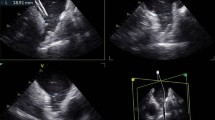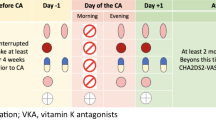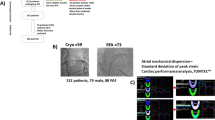Abstract
Purpose of Review
Macro-reentrant atrial tachycardias can occur in many patients after cardiac valve surgery. This review highlights the risk factors and special considerations for managing mitral annular flutter after mitral valve surgery.
Recent Findings
Perimitral annular flutter wavefront usually rotates clockwise or counterclockwise, supported by endocardial structures and low-voltage, slow conduction areas. Recent studies have shown the benefits of a steerable sheath while manipulating it near the mitral valve and multipolar mapping catheter to confirm PV isolation, which is necessary to ensure enduring blocks across the mitral isthmus. Integration of the latest high-density mapping techniques with fluoroscopic images into diagnostic evaluation helps better delineate the flutter circuit and reduce the risk of radiation exposure and complications like catheter entrapment.
Summary
In mitral valve surgery patients, mitral annular flutter is not uncommon. Hybrid thoracoscopic surgical techniques with subsequent percutaneous catheter-based ablation have been shown to reduce the cumulative risk of post-combined procedure risk of perimitral annular flutter. The details of surgical methods by the cardiothoracic surgical team might help better delineate the mechanisms of mitral annular flutter.





Similar content being viewed by others
Abbreviations
- AF:
-
Atrial fibrillation
- AFL:
-
Atrial flutter
- AAFL:
-
Atypical atrial flutter
- AAD:
-
Antiarrhythmic drugs
- BB:
-
Bachman bundle
- CS:
-
Coronary sinus
- CD:
-
Charge density
- CMP:
-
Cox maze procedure
- EGM:
-
Electrogram
- FDG:
-
F-fluorodeoxyglucose
- LAAW:
-
Left atrial anterior wall
- LMIL:
-
Lateral mitral isthmus line
- LAT:
-
Local activation time
- MAT:
-
Mitral annular tachycardia
- MAF:
-
Mitral annular flutter
- SMIL:
-
Septal mitral isthmus line
- VA:
-
Ventricular arrhythmia
- VT:
-
Ventricular tachycardia
References
Papers of particular interest, published recently, have been highlighted as: • Of importance •• Of major importance
Ko Ko NL, Sriramoju A, Khetarpal BK, Srivathsan K. Atypical atrial flutter: review of mechanisms, advances in mapping and ablation outcomes. Curr Opin Cardiol. 2022;37(1):36–45.
Wang XH, Kong L.C., Shuang T, Li Z, Pu J. Macro-reentrant atrial tachycardia after tricuspid or mitral valve surgery: is there difference in electrophysiological characteristics and effectiveness of catheter ablation? B.M.C. Cardiovasc Disord. 2021;21(1):538.
Egami Y, Ukita K, Kawamura A, Nakamura H, Matsuhiro Y, Yasumoto K, et al. Electrophysiological characteristics of atrial tachycardia after mitral valve surgery via a superior transseptal approach. Circ Arrhythm Electrophysiol. 2021;14(4): e009437.
Hu W, Zhou D, Hua B, Yang G, Chen H, Ju W, et al. Flutter wave morphology of peri-mitral atrial flutters is mainly determined by right atrial activation: insights from high-resolution mapping. Circ Arrhythm Electrophysiol. 2020;13(9): e008446.
Wasmer K, Monnig G, Bittner A, Dechering D, Zellerhoff S, Milberg P, et al. Incidence, characteristics, and outcome of left atrial tachycardias after circumferential antral ablation of atrial fibrillation. Heart Rhythm. 2012;9(10):1660–6.
Mascia G, Sartori P, Porto I. Effective and fast characterization of a complex atrial flutter in patient with previous atrial surgery and ablation procedure: The importance of new ultra-high-density mapping tools. Clin Case Rep. 2020;8(12):3458–62.
Balt JC, Klaver MN, Mahmoodi BK, van Dijk VF, Wijffels M, Boersma LVA. High-density versus low-density mapping in ablation of atypical atrial flutter. J Interv Card Electrophysiol. 2021;62(3):587–99.
Franco E, Lozano Granero C, Matia R, Hernandez-Madrid A, Sanchez I, Zamorano JL, et al. High-density mapping with fragmentation analysis in patients with reentrant atrial tachycardias (MAP-FLURHY study). J Interv Card Electrophysiol. 2021.
Markowitz SM. Detecting critical channels in perimitral flutter: will ripple mapping make a splash? JACC Clin Electrophysiol. 2021;7(5):591–3.
Ramak R, Chierchia GB, Paparella G, Monaco C, Miraglia V, Cecchini F, et al. Novel noncontact charge density map in the setting of post-atrial fibrillation atrial tachycardias: first experience with the Acutus SuperMap Algorithm. J Interv Card Electrophysiol. 2021;61(1):187–95.
Adragao P, Matos D, Costa FM, Carmo P, Cavaco D, Rodrigues G, et al. A new electrophysiologic triad for identification and localization of the critical isthmus in atrial flutter. Rev Port Cardiol (Engl Ed). 2020;39(6):309–14.
Mountantonakis S, Frankel DS, Hutchinson MD, Dixit S, Riley M, Callans DJ, et al. Feasibility of catheter ablation of mitral annular flutter in patients with prior mitral valve surgery. Heart Rhythm. 2011;8(6):809–14.
Lopes J, Sousa PA, Elvas L, Goncalves L. Successful retrieval of a broken PentaRay catheter spine in a patient with mechanic mitral valve prosthesis. J Interv Card Electrophysiol. 2021;61(3):625–6.
Gutierrez Ballesteros G, Jimenez Jaimez J, Sanchez Millan P, Macias Ruiz R, Molina Lerma M, Tercedor Sanchez L, et al. Utility and feasibility of the CartoUnivu system for atrial flutter ablation in patients with mechanical prosthetic valves. Indian Pacing Electrophysiol J. 2021;21(1):51–3.
Aldaas OM, Lupercio F, Lin AY, Han FT, Hoffmayer KS, Raissi F, et al. Ablation of mitral annular flutter ablation utilizing a left atrial anterior line versus a lateral mitral isthmus line: a systematic review and meta-analysis. J Interv Card Electrophysiol. 2022;63(1):87–95.
Pathik B, Choudry S, Whang W, D’Avila A, Koruth J, Sofi A, et al. Mitral isthmus ablation: A hierarchical approach guided by electroanatomic correlation. Heart Rhythm. 2019;16(4):632–7.
Ouyang F, Maurer T. Choose your battles: catheter ablation of perimitral flutter. JACC Clin Electrophysiol. 2019;5(11):1300–2.
Hamoud NS, Abrich VA, Shen WK, Mulpuru SK, Srivathsan K. Achieving durable mitral isthmus block: Challenges, pitfalls, and methods of assessment. J Cardiovasc Electrophysiol. 2019;30(9):1679–87.
Nishiyama T, Kimura T, Fujisawa T, Nakajima K, Kunitomi A, Kashimura S, et al. Mitral isthmus ablation using a circular mapping catheter positioned in the left atrial appendage as a reference for conduction block. Oncotarget. 2017;8(32):52724–34.
Cox JL, Churyla A, Malaisrie SC, Pham DT, Kruse J, Kislitsina ON, et al. A Hybrid Maze Procedure for Long-Standing Persistent Atrial Fibrillation. Ann Thorac Surg. 2019;107(2):610–8.
Kajiyama T, Kondo Y, Ueda M, Nakano M, Nakano M, Watanabe M, et al. Catheter ablation of atrial tachyarrhythmias after a Maze procedure: A single center experience. J Cardiol Cases. 2019;19(3):89–92.
Yang YC, Aung TT, Doshi H, Bailin SJ. Epicardial bridge via the coronary sinus musculatures revealed by ultra-high-definition mapping. J Electrocardiol. 2020;61:106–11.
Ioannidis P, Christoforatou E, Zografos T, Charalambopoulos P, Kouvelas K, Christoulas G, et al. Incidence, electrophysiological characteristics, and long-term follow-up of perimitral atrial flutter in patients with previously confirmed mitral isthmus block. J Arrhythm. 2021;37(3):584–96.
Isogai R, Matsuo S, Narui R, Seki S, Yoshimura M, Yamane T. Perimitral atrial flutter with partial conduction block between left atrium and coronary sinus. HeartRhythm Case Rep. 2019;5(4):179–82.
Nakashima T, Duchateau J, Vlachos K, Pambrun T, Jais P, Derval N. Partial participation of the coronary sinus owing to longitudinal dissociation during peri-mitral atrial flutter. Europace. 2021;23(6):957.
Lu Y, Nazari A, Buck A, Tung R. Epicardial recordings of Bachmann bundle activation during refractory mitral flutter with endocardial block. HeartRhythm Case Rep. 2020;6(6):341–3.
Takigawa M, Vlachos K, Martin CA, Bourier F, Denis A, Kitamura T, et al. Acute and mid-term outcome of ethanol infusion of vein of Marshall for the treatment of perimitral flutter. Europace. 2020;22(8):1252–60.
Chou CY, Chung FP, Chang HY, Lin YJ, Lo LW, Hu YF, et al. Prediction of recurrent atrial tachyarrhythmia after receiving atrial flutter ablation in patients with prior cardiac surgery for valvular heart disease. Front Cardiovasc Med. 2021;8: 741377.
Funding
This research did not receive any specific grant from funding agencies in public, commercial or not-for-profit sectors.
Author information
Authors and Affiliations
Corresponding author
Ethics declarations
Conflict of Interest
Drs Sriramoju, Elbanna, Cheema, Ko Ko and Srivathsan declare that they have no conflict of interest.
Human and Animal Rights and Informed Consent
This article does not contain any studies with human or animal subjects performed by the authors.
Additional information
Publisher's Note
Springer Nature remains neutral with regard to jurisdictional claims in published maps and institutional affiliations.
This article is part of the Topical Collection on Arrhythmias
Rights and permissions
About this article
Cite this article
Sriramoju, A., Elbanna, M., Cheema, K.P. et al. Risk factors and Management of Mitral Annular Atrial Flutter After Mitral Valve Surgery. Curr Cardiovasc Risk Rep 16, 87–96 (2022). https://doi.org/10.1007/s12170-022-00696-w
Accepted:
Published:
Issue Date:
DOI: https://doi.org/10.1007/s12170-022-00696-w




